Is Korea Safer? The First Anniversary of the Itaewon Disaster
In 2022, social distancing, business-hours restrictions, and the mask equirement due to COVID-19 were lifted in Korea. Halloween was celebrated as the first festival when quarantine measures were lax. On Oct. 29, 2022, the weekend before Halloween, people flocked to Itaewon to celebrate Halloween. With surge after surge, Itaewon started to fill up, then led to a stampede. Oct. 29th, a festive day, turned into a day of horror, countless victims, and mourning families, a day which will live in infamy and is now known as the “Itaewon disaster.” Itaewon is Seoul’s first special tourist zone and a representative multicultural street. In the past, Yongsan was used as a US military base, becoming an area where many foreigners live. Since Halloween is a traditional festival in English-speaking countries, the festival was held in Itaewon, an entertainment district with many foreigners. Accordingly, one year later, in commemoration of the first anniversary of the Itaewon disaster, The Sogang Herald would like to look back on the last year and consider how South Korea has changed since the accident.
Itaewon on Oct. 29, 2022
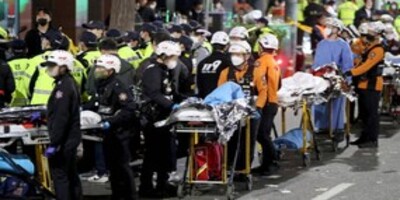 © News1
© News1
At around 10:15 p.m. on Oct. 29, 2022, the day before Halloween, a stampede occurred as a sizable crowd gathered in an alley near the Hamilton Hotel in Itaewon-ro, Yongsan-gu, Seoul. The crowd heading towards Itaewon Station from World Food Culture Street was pushed into the downhill alley west of the Hamilton Hotel and entangled with each other, trying to go up. The majority of the casualties occurred concentrated in a space that was 3.2m wide, 5.7m long, and had an average slope of 10%. A total of 159 individuals lost their lives, of which 26 were foreigners, and 196 people were injured, including 33 seriously.
The road was a slippery sidewalk block with alcohol sprinkled on it. Additionally, the narrow downhill alley where the disaster occurred can only fit six adults horizontally. If calculating the optimal number of people in this alley based on the “Fermi estimation method,”[1] the maximum capacity for the street is only around 400 people. However, at the time of the accident, more than 1,000 people crammed into this alley alone, and a load of at least 180 tons was applied to the people on the bottom. The bodies swayed regardless of the person’s will. There were many cases where a person fell and was crushed to death, as well as suffocating while standing. What made the initially narrow alleys even narrower were illegal expansions. Of the 16 buildings in the alley, seven were identified as violating building codes due to unlawful expansion. According to building laws, roads must be at least 4m wide, and the building register also specifies the road width as 4m. However, the Hamilton Hotel was completed in 1970, before building restrictions were established in urban planning. Most buildings, including the main terrace and the additional event booth, exceeded the building limits. Even after the implementation of the building limit line, a temporary pink steel wall was attached to the road and extended by about 10 meters without permission.
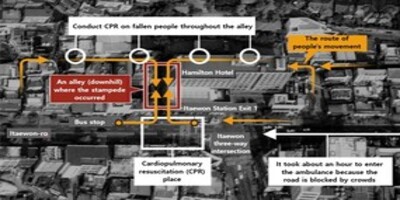 © Dongailbo
© Dongailbo
The police department was already aware of the stampede risk as they were warned about it 79 times four hours before the accident. However, the fire department requested that the festival be halted at 11:19 p.m. and the police crowd management team arrived at 11:40 pm, five hours after the first report. Before the stampede, the police had difficulty controlling the crowd due to insufficient manpower. The police expected that about 100,000 people would gather and deployed 137 police officers to the scene. However, 300,000 people gathered in Itaewon, far exceeding the expected number of 100,000 people. In addition, the fire department and police were dispatched, but the public blocked the roads, slowing down the rescue vehicle, making it arrive hours later. When they arrived, they tried to grab the arms of the victims underneath and pull them out, but piles of people stacked on top of each other made this impossible. Even if they were rescued, they could not have been identified as their belongings were often mixed up and missing. One of the reasons that fueled the tragedy was the misunderstanding by citizens who could not differentiate between police officers amidst Halloween costumes. The initial response was delayed as the police officers who came to control and rescue the scene were mistaken for people who had come to enjoy themselves and the festivities. Accordingly, with the cooperation of large portal sites, measures were taken to block searches related to police uniforms. Authorities set up a string of sting operations to arrest individuals linked to selling police uniforms at online and offline markets.
After the disaster, there were numerous victims. Bereaved families, witnesses, police officers, firefighters, paramedics, and doctors reported cases of PTSD[2]. The damage to the Itaewon commercial district was also extensive. Compared to the fourth week of October 2022, according to Seoul City Hall, the floating population in the area decreased by 30%, and small business sales decreased by 60% in the second week of November 2022. Also, there was controversy over the naming of the disaster. There were many concerns that if the area’s name were included, as in the “Itaewon disaster,” it would stigmatize Itaewon as dangerous and cause additional pain and damage to residents and merchants. The day after the accident, the Korean Psychological Association announced the name of the accident as the “10.29 disaster” to prevent regional hatred, but the names are still used interchangeably.
Itaewon on Oct. 29, 2023
Traces of the Itaewon disaster still remain, and a memorial space remains near Exit 1 of Itaewon Station. Fortunately, compared to 2022, Itaewon is becoming more vibrant. In May 2023, the floating population in Itaewon 1-dong recovered to 75.6% compared to the fourth week of October 2022. Sales in the Itaewon commercial district also reached 60% of the fourth week of October 2022. However, this is only an improvement over the disaster; Itaewon is still a dark and cold deserted street with few stores in operation.
After the Itaewon disaster, citizens’ safety wariness also changed. A year later, caution about stampede accidents increased. The number of security guards has increased in densely populated areas of public institutions such as subways. Additionally, there is a lot of discussion about the crisis in crowded situations such as celebrity concerts and festivals.
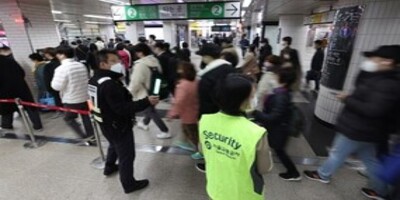 © YONHAP NEWS
© YONHAP NEWS
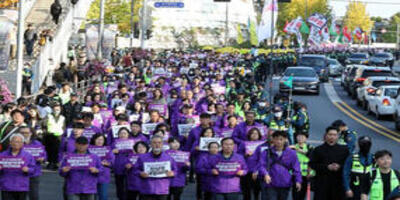 © Hankookilbo
© Hankookilbo
On Oct. 29, 2023, the bereaved families and the Citizens’ Countermeasures Committee continued their remembrance and solidarity by wearing purple jackets to signify commemoration and remembrance. A religious prayer service was held to comfort the souls of the 159 victims. After the march, the “Citizens’ Memorial Rally for the 1st Anniversary of the Oct. 29 Itaewon Disaster” was held at Seoul Plaza in Jung-gu, Seoul, for about two hours. The Citizens’ Countermeasures Committee issued a joint declaration calling for preventing secondary harm to the families and victims of the disaster and enacting the Itaewon Disaster Special Act. The enactment of a special law is necessary to guarantee the rights of victims, such as the “right to know the truth of the disaster” and to find out the truth and prevent recurrence. Ten thousand people participated, including citizens who visited the memorial space. The Office of the President regarded the memorial service as a political rally and announced its intention not to attend, instead attending the memorial sermon at the Youngahm church. Marking the first anniversary of the Itaewon disaster, President Yoon prayed for the victims to rest in peace. The government announced that it would prepare additional safety measures to prevent a recurrence of the disaster.
Actions from the Government and Related Organizations
After the disaster, the police emphasized that the safety manual could not be implemented in the Itaewon disaster because there was no organizer. Yet, it was far from the truth. Yongsan-gu Office and Yongsan Police Station have prepared crowd management measures each year before Halloween. In 2022, they created a Halloween Day Security Conditions Analysis and Response Plan Report centered on Itaewon. They also held countermeasures meetings and made plans to increase manpower. However, these measures were not authorized by the higher-ups of the police organization, for reasons unknown to the public. The Seoul Metropolitan Police Agency omitted the report from its security operation plan. The Itaewon Police Station requested support from the security team but were rejected, and only one unit of the transportation security team (approximately 20 people) was supported. On the day of the disaster, the higher-ups in the police ordered a “drug crackdown” rather than maintaining order. Even immediately after the disaster, drug enforcement officers were not adequately informed of the situation. In addition, the command team focused only on the rally near the Yongsan Presidential Office while receiving incident reports. As the information was delayed due to the chain of command, requests for joint firefighting response and deployment to the scene were also delayed. Accordingly, the National Police Agency’s Special Investigation Headquarters arrested six people, including the former chief of the Yongsan Police Station, police officials, the district chief, and the fire chief who responded to the scene. They were accused of criminal negligence, causing death or injury by not performing their duties properly.
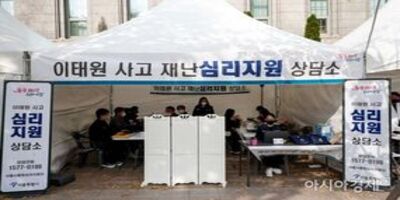 © Asiae economic
© Asiae economic
To deal with the damage from the Itaewon disaster, the government declared the Yongsan-gu area a special disaster area and November 5th a “national mourning period.” Psychological counseling centers were established throughout the region to support bereaved families and survivors. In addition, psychological counseling was provided to witnesses of the Itaewon disaster and general citizens through the “24-hour mental health crisis calls.” Through the Mind-Safe Bus, mental health specialists provided psychological support services such as mental health evaluation, and counseling. However, no specialist counseling was offered. Participants pointed out that the government was unable to provide professional trauma psychological counseling or approach bereaved families of survivors in detail. Additionally, the city government of Seoul implemented a two-track support policy for small business owners in the Itaewon area to overcome damage to the commercial district. It is an emergency loan of up to 30 million won per company, 2% per year, and a plan to stimulate sales. Two hundred twenty-eight applications worth 6.84 billion won applied for the Itaewon Commercial District Recovery Fund.
So, has the government prepared measures as of 2023? No fact-finding and specific measures have yet been taken, and the punishment of those responsible is unclear. The special law, which includes the establishment of a special investigation committee for the Itaewon disaster, was fast-tracked in June this year. However, it is still pending approval in the National Assembly’s Legislation and Judiciary Committee. In January, legislation was announced for the “Partial Amendment to Building Ordinances,” increasing the fine for violating building codes by up to four times. Still, the passage is blocked due to opposition from the city council. In addition, those involved, including the Yongsan-gu chief and the former head of the Seoul Metropolitan Police Agency’s intelligence department, who were arrested and charged, were released on bail.
There are also criticisms about the government’s support for victims and merchants. Victims were able to receive treatment support without proof for six months after the disaster, but after April, they had to prove that they were “victims” to receive additional treatment. For merchants, “Itaewon Daily Life Recovery Measures” and “Hey Itaewon” are underway. These are one of the factors that allowed the Itaewon commercial district to recover. The representative activity is the provision of gift certificates, but many people became aware of the policy support late, leading to criticism of the lack of publicity. Additionally, since gift certificates can be used in 6 different districts, people use them in Haebangchon or Hannam-dong rather than the areas near the Itaewon disaster. Only when the relevant commercial district is restored will the entire Itaewon commercial district recover, thus tweezer support is needed in areas near the disaster. Proper policy is needed for survivors, bereaved families, rescuers, and merchants.
Commemorating the First Anniversary of the Itaewon Disaster
The Sogang Herald has reflected on last year when a festive event became a disaster. A year later, South Korea has not been able to take meaningful measures against the Itaewon disaster. Through the enactment of a special law, significant progress must be made in guaranteeing the rights of disaster victims, investigating the truth, and preparing measures to prevent recurrence. Investigating the truth of the disaster should be a process of learning lessons to make our society safer. It is hoped that the conflict of opinion over the enactment of the special law will be smoothly resolved through sufficient dialogue and deliberation in the National Assembly. The Sogang Herald, commemorating the first anniversary of the Itaewon disaster, prays sincerely for the peace of its victims. Lest we forget the tragedy.
By Yun-seon Ka (Int’l & Social Reporter Reporter)
yunseon@sogang.ac.kr
[1] Estimation method used by the police to estimate the number of people at a gathering. It assumes that 9 to 10 adult men can stand and 6 people can sit in 3.3㎡, and expands this to the total.
[2] post-traumatic stress disorder
